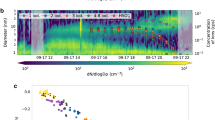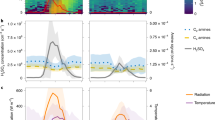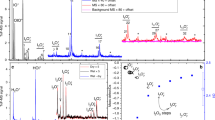Abstract
The formation of marine aerosols and cloud condensation nuclei—from which marine clouds originate—depends ultimately on the availability of new, nanometre-scale particles in the marine boundary layer. Because marine aerosols and clouds scatter incoming radiation and contribute a cooling effect to the Earth's radiation budget1, new particle production is important in climate regulation. It has been suggested that sulphuric acid—derived from the oxidation of dimethyl sulphide—is responsible for the production of marine aerosols and cloud condensation nuclei. It was accordingly proposed that algae producing dimethyl sulphide play a role in climate regulation2, but this has been difficult to prove and, consequently, the processes controlling marine particle formation remains largely undetermined3,4. Here, using smog chamber experiments under coastal atmospheric conditions, we demonstrate that new particles can form from condensable iodine-containing vapours, which are the photolysis products of biogenic iodocarbons emitted from marine algae. Moreover, we illustrate, using aerosol formation models, that concentrations of condensable iodine-containing vapours over the open ocean are sufficient to influence marine particle formation. We suggest therefore that marine iodocarbon emissions have a potentially significant effect on global radiative forcing.
This is a preview of subscription content, access via your institution
Access options
Subscribe to this journal
Receive 51 print issues and online access
$199.00 per year
only $3.90 per issue
Buy this article
- Purchase on Springer Link
- Instant access to full article PDF
Prices may be subject to local taxes which are calculated during checkout




Similar content being viewed by others
References
Slingo, A. Sensitivity of the Earth's radiation budget to changes in low clouds. Nature 343, 49–51 (1990)
Charlson, R. J., Lovelock, J. E., Andreae, M. O. & Warren, S. G. Oceanic phytoplankton, atmospheric sulphur, cloud albedo and climate. Nature 326, 655–661 (1987)
Katoshevski, D., Nenes, A. & Seinfeld, J. H. A study of processes that govern the maintenance of aerosols in the marine boundary layer. J. Aerosol. Sci. 30, 503–532 (1999)
Capaldo, K. P., Kasibhatla, P. & Pandis, S. N. Is aerosol production within the remote marine boundary layer sufficient to maintain observed concentrations? J. Geophys. Res. 104, 3483–3500 (1999)
Korhonen, P. et al. Ternary nucleation of H2SO4, NH3, and H2O in the atmosphere. J. Geophys. Res. 104, 26349–26353 (1999)
Kulmala, M., Pirjola, L. & Mäkelä, J. M. Stable sulphate clusters as a source of new atmospheric particles. Nature 404, 66–69 (2000)
Pirjola, L., O'Dowd, C. D., Brooks, I. M. & Kulmala, M. Can new particle formation occur in the clean marine boundary layer? J. Geophys. Res. 105, 26531–26546 (2000)
O'Dowd, C. D. et al. A dedicated study of new particle formation and fate in the coastal environment (PARFORCE): Overview of objectives and achievements. J. Geophys. Res. (in the press)
Berresheim, H. et al. Gas-aerosol relationships of H2SO4, MSA and H: Observations in the coastal marine boundary layer at Mace Head, Ireland. J. Geophys. Res. (in the press)
Väkevä, M., Hämeri, K. & Aalto, P. Hygroscopic properties of nucleation mode and Aitken mode particles during and outside nucleation bursts in west coast of Ireland. J. Geophys. Res. (in the press)
Mäkelä, J. M. et al. Biogenic iodine emissions and identification of end-products in coastal ultrafine particles during nucleation bursts. J. Geophys. Res. (in the press)
Cocker, D. R., Flagan, R. C. & Seinfeld, J. H. State-of-the-art chamber facility for studying atmospheric aerosol chemistry. Environ. Sci. Technol. 35, 2594–2601 (2001)
Carpenter, L. J. et al. Short-lived alkyl iodides and bromides at Mace Head, Ireland: Links to biogenic sources. J. Geophys. Res. 104, 1679–1689 (1999)
Laturnus, F., Giese, B., Wiencke, C. & Adams, F. Low molecular-weight organoiodine and organobromine compounds released by polar macroalgae—the influence of abiotic factors. Fresenius J. Anal. Chem. 368, 297–302 (2000)
Giese, B., Laturnus, F., Adams, F. C. & Wiencke, C. Release of volatile iodinated C1-C4 hydrocarbons by marine macro from various climate zones. Environ. Sci. Technol. 33, 2432–2439 (1999)
Goodwin, K. D., North, W. J. & Lidstrom, M. E. Production of bromoform and dibromomethane by giant kelp: Factors affecting release and comparison to anthropogenic bromine sources. Limnol. Oceaanogr. 42, 1725–1734 (1997)
Anache, S., Kamagata, Y., Kanagawa, T. & Kimuramatsu, Y. Bacteria mediate methylation of iodine in marine and terrestrial environments. Appl. Environ. Microbiol. 67, 2718–2722 (2001)
McFiggans, G. et al. A model study of iodine chemistry in the marine boundary layer. J. Geophys. Res. 105, 14371–14386 (2000)
Allan, B. J., Plane, J. M. C. & McFiggans, G. Observations of OIO in the remote marine boundary layer. Geophys. Res. Lett. 28, 1945–1948 (2001)
Dal Maso, M., Kulmala, M., Mäkelä, J. M., Aalto, P. & O'Dowd, C. D. Condensation and coagulation sinks and the formation of nucleation mode particles in coastal and boreal forest boundary layers. J. Geophys. Res. (in the press)
Lushnikov, A. A. & Kulmala, M. Nucleation controlled formation and growth of disperse particles. Phys. Rev. Lett. 81, 5165–5168 (1998)
Houghton, J. T. et al. Climate Change 2001 – The Scientific Basis (Cambridge Univ. Press, Cambridge, 2001)
Leck, C. & Bigg, E. K. Aerosol production over remote marine areas—A new route. Geophys. Res. Lett. 23, 3577–3580 (1999)
Murphy, D. M., Thomson, D. S. & Middlebrook, A. M. Bromine, iodine and chlorine in single aerosol particles at Cape Grim. Geophys. Res. Lett. 24, 3197–3200 (1997)
Gäbler, H. E. & Heumann, K.-G. Determination of particulate iodine in aerosols from different regions by size fractioning impactor sampling and IDMS. Int. J. Anal. Chem. 50, 129–146 (1993)
Wimschneider, A. & Heumann, G. Iodine: speciation in size fractioned atmospheric particles by isotope dilution mass spectrometry. Fresenius J. Anal. Chem. 353, 191–196 (1995)
Baker, A. R., Thompson, D., Campos, M. L. A. M., Parry, S. J. & Jickells, T. D. Iodine concentration and availability in atmospheric aerosol. Atmos. Environ. 34, 4331–4336 (2000)
Huang, S., Arimoto, R. & Rahn, K. A. Sources and source variations for aerosol at Mace Head, Ireland. Atmos. Environ. 35, 1421–1437 (2001)
Jayne, J. T. et al. Development of an aerosol mass spectrometer for size and composition analysis of submicron particles. Aerosol Sci. Technol. 33, 49–70 (2000)
Bloss, W. J., Rowley, D. M., Cox, R. A. & Jones, R. L. Kinetics and products of the IO self-reaction. J. Phys. Chem. A 105, 7840–7854 (2001)
Acknowledgements
This work was funded by the European Commission, the Finnish Academy, the US Department of Energy and the National Development Plan and Environmental Protection Agency, Ireland.
Author information
Authors and Affiliations
Corresponding author
Ethics declarations
Competing interests
The authors declare that they have no competing financial interests.
Rights and permissions
About this article
Cite this article
O'Dowd, C., Jimenez, J., Bahreini, R. et al. Marine aerosol formation from biogenic iodine emissions. Nature 417, 632–636 (2002). https://doi.org/10.1038/nature00775
Received:
Accepted:
Issue Date:
DOI: https://doi.org/10.1038/nature00775
This article is cited by
-
Atmospheric new particle formation from the CERN CLOUD experiment
Nature Geoscience (2023)
-
The gas-phase formation mechanism of iodic acid as an atmospheric aerosol source
Nature Chemistry (2023)
-
Climate changes modulated the history of Arctic iodine during the Last Glacial Cycle
Nature Communications (2022)
-
Antarctic ozone hole modifies iodine geochemistry on the Antarctic Plateau
Nature Communications (2021)
-
Analysis of Positive and Negative Atmospheric Air Ions During New Particle Formation (NPF) Events over Urban City of India
Aerosol Science and Engineering (2021)
Comments
By submitting a comment you agree to abide by our Terms and Community Guidelines. If you find something abusive or that does not comply with our terms or guidelines please flag it as inappropriate.



